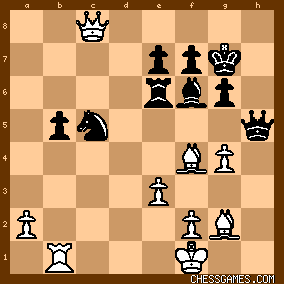| May-09-11 | | jepflast: This is one of the games featured in Irving Chernev's book The Chess Companion, although he gives the name of Petrosian's opponent as "Aranovich". |
|
| May-10-11 | | sevenseaman: Very pretty; a logical flow of moves. |
|
| Aug-10-12 | | backrank: Look at the position after White's 13th move:

click for larger viewWhite has dispensed with castling either side, he has attacked with the h-pawn before the opponent's castling, and even more, he hasn't a single piece developed toward the center, and none of his center pawns have moved at all so far! This is the ultimate violation of the classical principles in chess. Good old Doc Siggy (Tarrasch) would have shuddered ... And yet, there's nothing wrong with the white position. |
|
| Aug-10-12 | | backrank: In the position after Black's 15th move, with the black queen sitting very comfortably in the center
click for larger viewPetrosian finds 16 d4! exd4 17 exd4! (but not 17 Bf4 Qf5! menacing the Rb1 and winning material in each variation, since now e4 is impossible due to dxe3 e.p.), and now the black queen has to leave (Qxd4?? 18 Bb2) 
click for larger viewIn the position after Black's 19th move

click for larger viewPetrosian again violates the classical principles by exchanging a center pawn (d4) for a rook pawn (a6), playing 20 Nxa6 Nxa6 (Bxg2 loses material by 21 Nxb8 Nxb8 22 Qd8+ and Black's counterattack via Qh1+ is useless since the white king easily escapes) 21 Qxa6 Bxd4 
click for larger viewIn the classical sense, Black's position is strong: all pieces are well developed, and his king is safe, while White's pieces look somewhat scattered, and his king is in the center. But Petrosian will soon prove that the black pieces aren't placed so efficiently. |
|
Aug-10-12
 | | perfidious: < backrank: ....This is the ultimate violation of the classical principles in chess. Good old Doc Siggy (Tarrasch) would have shuddered ...> True, though this failed to stop the good doctor from playing openings of the hypermodern school at the end of his career-even the line popularised by his bitter rival Nimzowitsch! Gilg vs Tarrasch, 1926 |
|
| Aug-10-12 | | backrank: 22 Bf4!, and Black can't play e5? because of 23 Qd6+ Kd8 24 Bc6 
click for larger viewand Black is totally lost (Qf5 25 Qxb8+ or Rd8 26 Rxb5); suddenly all white pieces work together, unfolding an overwhelming superiority, which proves they must have been placed well even before, when this had not been so noticeable at first glance! But, after 22 Bf4, Black sees a chance to place all his pieces in attacking positions toward the white king; he plays ... Nc5 23 Qc6 Rb6! 24 Qc8+ (Qxb6?? Nd3+) Kg7 25 Kf1! (prophylaxis, and at the same time inviting black to the next move) Re6? (seemingly strong but in fact losing) 
click for larger viewNow Petrosian proves that the 'attacking' position of the black pieces is in fact a dependent position; the knight is covered by bishop and queen. Once they are lured away, the knight will fall. Hence 26 e3 Bf6 (unsuspecting, otherwise he would have tried Qf5!?) 27 g4! winning a piece: 
click for larger view |
|
| Aug-10-12 | | backrank: <perfidious> Maybe the good old doctor was one of those who didn't practice what they preached? ;) Probably he wasn't the man who was able to admit that everything he had taught his whole life was wrong ... of course it wasn't, but there were many exceptions to his 'rules', too many exceptions. He was too intelligent a man not to realize these exceptions, but admitting this fact? No, just impossible for him! His personality didn't let him do that! I have once read that Tarrasch was 'dogmatic in his writings, but not in his play'. Maybe this is a most suitable description. Those who were dogmatic in their play, too, didn't play as strongly as he did. |
|
| Aug-10-12 | | backrank: Now I'm completing my analysis of the above game before checking it with an engine ... there's not much to be said about the finish, after losing a piece, and particularly after 30 Qc4! Black could as well have resigned:
click for larger viewWhite's not only threatening the Ra2, but also Bh6+! conquering the queen. That's why Black must play Qe6, acceding to an endgame a piece down. Maybe he plays on since there are very few pawns left, but Petrosian disposes of his task with impeccable technique. |
|
| Aug-10-12 | | backrank: Addendum after a quick check of the above analysis with Rybka: After 23 ... Ne6 (instead of Re6) Rybka judges the position totally even. Even 23 ... Re6 is not losing, after 24 e3 my suggestion Qf5 seems have saved the game by a hair. |
|
|
|
|





































